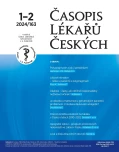Možné přístupy v hodnocení adherence
Authors:
Alena Pilková
Authors‘ workplace:
Oddělení klinické farmakologie a farmacie, Farmakologický ústav 1. LF UK a VFN v Praze
Published in:
Čas. Lék. čes. 2024; 163: 18-23
Category:
Review Articles
Overview
Many patients do not take their medication as prescribed by their physician, either intentionally or unintentionally. This phenomenon, most referred as nonadherence, leads to suboptimal treatment response and increased healthcare costs. To detect nonadherence, in addition to indirect methods, we also use direct methods that detect the presence of the drug in patient's body. However, by simple assessment based on the presence or the absence of a measurable concentration of the drug or its metabolite in a blood sample, it is difficult to distinguish complete adherence from partial adherence, i.e., a situation where the patient takes the drug irregularly, or from masked adherence, where the patient takes his medicine only once before a medical appointment.
A possible refinement may be allowed using pharmacokinetic simulations, which estimate whether the measured value corresponds to the expected drug level after a single or short-term administration, or whether it represents steady state confirming long-term adherence. Not only an analysis of a parent drug, but also its metabolite with more favourable pharmacokinetic properties (especially with longer half-life) can be used.
Since, in many cases, nonadherence can be caused by several different reasons, multiple approaches in its detection and management are required and a multidisciplinary approach should be involved.
Keywords:
adherence, compliance, drug management, therapeutic drug monitoring
Sources
- Kleinsinger F. The unmet challenge of medication nonadherence. Perm J 2018; 22: 18-033.
- Jimmy B, Jose J. Patient medication adherence: measures in daily practice. Oman Med J 2011; 26: 155–159.
- Fraser S. Concordance, compliance, preference or adherence. Patient Prefer Adherence 2010; 4: 95–96.
- Lee EKP, Poon P, Yip BHK et al. Global burden, regional differences, trends, and health consequences of medication nonadherence for hypertension during 2010 to 2020: a meta-analysis involving 27 million patients. J Am Heart Assoc 2022; 11: e026582.
- SPC Enerzair Breezhaler. Dostupné na: www.ema.europa.eu/en/documents/product-information/enerzair-breezhaler-epar-product-information_cs.pdf
- Adolfsson P, Hartvig NV, Kaas A et al. Increased time in range and fewer missed bolus injections after introduction of a smart connected insulin pen. Diabetes Technol Ther 2020; 22: 709–718.
- Lugaresi A. RebiSmart™ (version 1.5) device for multiple sclerosis treatment delivery and adherence. Expert Opin Drug Deliv 2013; 10(2): 273–283.
- Alipour A, Gabrielson S, Patel PB. Ingestible sensors and medication adherence: focus on use in serious mental illness. Pharmacy (Basel) 2020; 8: 103.
- Chai PR, Vaz C, Goodman GR et al. Ingestible electronic sensors to measure instantaneous medication adherence: a narrative review. Digit Health 2022; 8: 20552076221083119.
- Williams B, Mancia G, Spiering W et al. 2018 ESC/ESH Guidelines for the management of arterial hypertension. Eur Heart J 2018; 39: 3021–3104.
- Widimský J, Filipovský J, Ceral J a kol. Diagnostické a léčebné postupy u arteriální hypertenze – verze 2022. Doporučení České společnosti pro hypertenzi. Hypertenze & kardiovaskulární prevence 2022; 2 (Suppl.).
- Češková E, Šilhán P, Kacířová I a kol. Terapeutické monitorování léčiv v psychiatrii. Doporučené postupy psychiatrické péče 2018. Psychiatrická společnost ČLS JEP, 13. 9. 2018. Dostupné na: https://postupy-pece.psychiatrie.cz/lecba/monitorovani-lecby-psychofarmaky/terapeuticke-monitorovani-leciv-v-psychiatrii
- Pilková A, Šíma M, Hartinger JM et al. Novel approach to adherence assessment based on parent drug and metabolite pharmacokinetics: pilot study with spironolactone. Biomed Pap Med Fac Univ Palacky Olomouc Czech Repub 2022, doi: 10.5507/bp.2022.048.
- Pilková A, Hartinger JM. Změny farmakokinetiky léčiv u obézních pacientů. Vnitř Lék 2020; 66: 465–471.
- Šíma M, Vodička M, Marešová V et al. Adherence with perindopril therapy: a pilot study using therapeutic drug monitoring of perindoprilat and an evaluation of the clearance estimation. Int J Clin Pharm 2017; 39: 1095–1100.
- Rostami-Hodjegan A, Amin AM, Spencer EP et al. Influence of dose, cigarette smoking, age, sex, and metabolic activity on plasma clozapine concentrations: a predictive model and nomograms to aid clozapine dose adjustment and to assess compliance in individual patients. J Clin Psychopharmacol 2004; 24: 70–78.
- Mason M, Cho Y, Rayo J, Gong Y et al. Technologies for medication adherence monitoring and technology assessment criteria: narrative review. JMIR Mhealth Uhealth 2022; 10: e35157.
- Anghel LA, Farcas AM, Oprean RN. An overview of the common methods used to measure treatment adherence. Med Pharm Rep 2019; 92: 117–122.
- Osman H, Alghamdi R, Gupta P. Review of the methods to measure nonadherence with a focus on chemical adherence testing. Translat Metab Syndr Res 2022; 5: 1–9.
Labels
Addictology Allergology and clinical immunology Angiology Audiology Clinical biochemistry Dermatology & STDs Paediatric gastroenterology Paediatric surgery Paediatric cardiology Paediatric neurology Paediatric ENT Paediatric psychiatry Paediatric rheumatology Diabetology Pharmacy Vascular surgery Pain management Dental HygienistArticle was published in
Journal of Czech Physicians

Most read in this issue
- Akatizie – častý, ale obtížně rozpoznatelný nežádoucí účinek?
- Polypragmazie a jak jí předcházet
- Lékové interakce – rizika u pacientů s polypragmazií
- Geografie zdraví – průzkum prostorových nerovností ve zdraví v Česku
